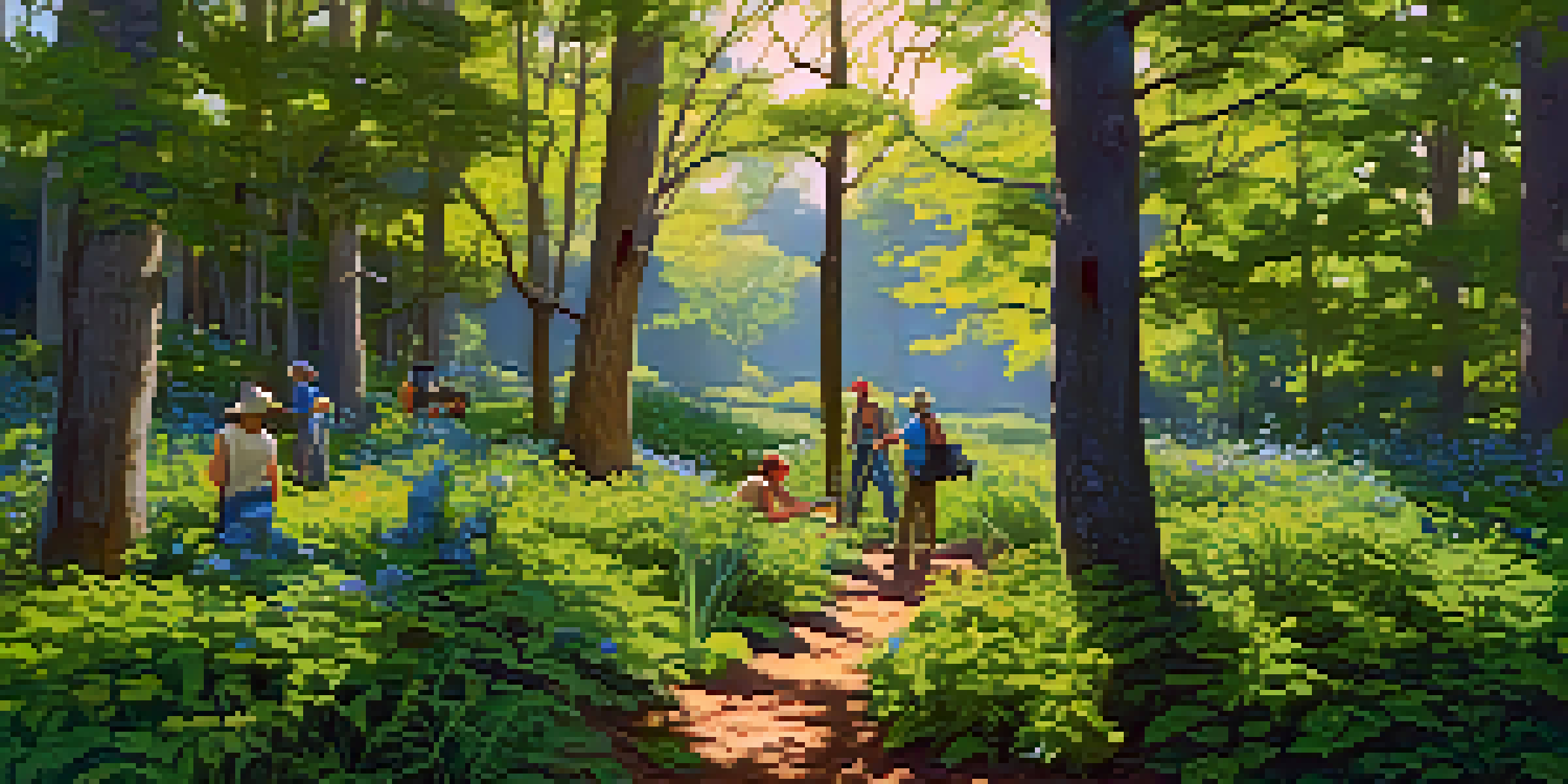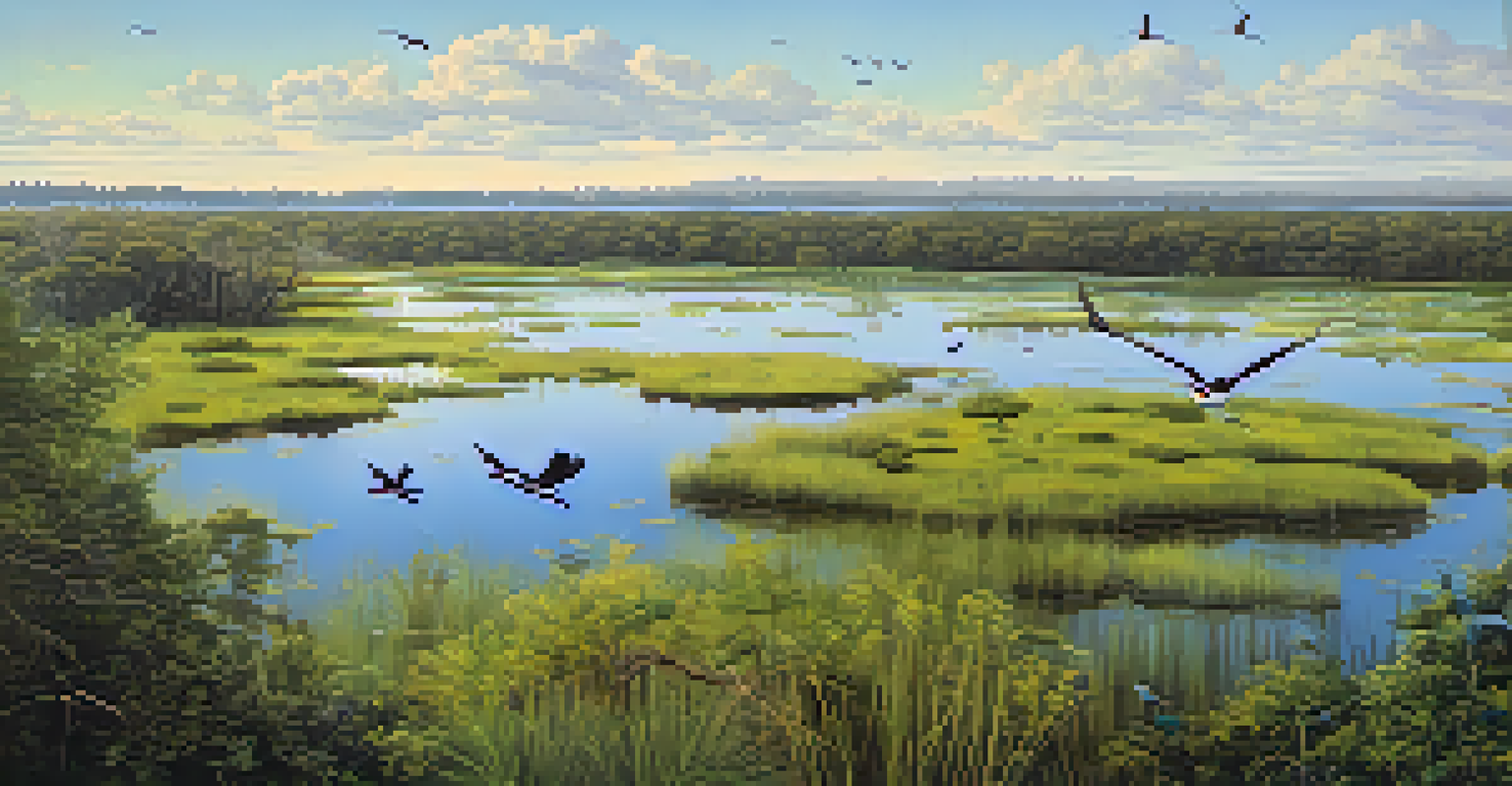Restoration Ecology: Combating Invasive Plant Species

Understanding Invasive Plant Species and Their Impact
Invasive plant species are non-native plants that disrupt local ecosystems. They often outcompete native flora for resources, leading to a decline in biodiversity. For instance, species like kudzu in the southeastern U.S. can smother native plants, altering habitats and food sources for wildlife.
Invasive species are a leading cause of species extinction and loss of biodiversity.
The impact of invasive species goes beyond just plant life; it affects entire ecosystems. When these invaders take over, they can change soil chemistry, water availability, and even fire regimes. This shift can make it increasingly difficult for native species to survive, leading to a domino effect on the ecosystem.
Understanding these dynamics is crucial in restoration ecology. By identifying the characteristics of invasive species, ecologists can devise targeted strategies to manage their spread and restore the balance of local ecosystems.
The Role of Restoration Ecology in Combatting Invasives
Restoration ecology focuses on returning ecosystems to their natural states. This science not only involves removing invasive species but also reintroducing native plants and restoring habitats. The goal is to create a thriving ecosystem where native flora and fauna can flourish.

To be effective, restoration efforts must be tailored to specific ecosystems. For example, a wetland restoration project may require different techniques than a forest restoration. By understanding the unique needs of each ecosystem, restoration ecologists can implement the most effective strategies.
Invasive Species Disrupt Ecosystems
Invasive plants outcompete native species, leading to decreased biodiversity and altered ecosystems.
Furthermore, restoration ecology emphasizes collaboration with local communities. Involving local stakeholders can enhance the success of restoration projects, as they often have valuable knowledge and a vested interest in the health of their environment.
Identifying and Prioritizing Invasive Species
The first step in addressing invasive plant species is identifying which ones pose the greatest threat. Not all invasive plants are equally harmful; some may be more aggressive in their spread or have a more significant impact on native species. Creating a priority list helps focus resources where they are needed most.
The restoration of native ecosystems is not just about plants; it's about creating a sustainable future for all species, including humans.
Ecologists often use criteria like the rate of spread, ecological impact, and the feasibility of control measures to prioritize invasive species. This systematic approach ensures that efforts are efficient and effective, addressing the most pressing issues first.
For example, the Asian honeysuckle is often prioritized in many regions due to its rapid growth and ability to outcompete native plants. By focusing on such species, restoration efforts can make a significant impact in a shorter amount of time.
Effective Methods for Controlling Invasive Plants
There are several methods for controlling invasive plant species, each with its own advantages and drawbacks. Mechanical removal, such as cutting or pulling invasive plants, is often effective but labor-intensive. This method can be particularly useful in small areas or when dealing with specific invasive species.
Chemical control, using herbicides, is another common approach. While effective, it raises concerns about potential harm to surrounding flora and fauna. Therefore, it's essential to use these chemicals judiciously and in conjunction with other methods to minimize environmental impact.
Restoration Requires Community Effort
Successful restoration ecology involves local communities in monitoring and maintaining ecosystems to ensure long-term health.
Biological control, which involves introducing natural predators or diseases, offers a promising alternative. However, this method requires thorough research to prevent unintended consequences. For instance, introducing a beetle to control purple loosestrife has shown success without harming native species.
Reintroducing Native Plants to Restore Balance
After invasive species have been managed, restoring native plants is crucial for ecosystem recovery. Native plants provide essential habitat and food for local wildlife, supporting a diverse ecosystem. They are also better adapted to local soil and climate conditions, making them more resilient in the long term.
Restoration projects often involve planting native species that are native to the region. This practice not only helps restore ecological balance but also enhances the area's aesthetic value. Imagine a once-invaded landscape blooming with local wildflowers instead of invasive weeds.
Collaborating with local nurseries and botanical gardens can aid in sourcing native plants. By using locally adapted varieties, restoration efforts can be more successful, as these plants are better suited to thrive in their original environments.
Monitoring and Maintaining Restored Ecosystems
Restoration isn't a one-time effort; it requires ongoing monitoring and maintenance. Regular assessments help identify any resurgence of invasive species and evaluate the health of restored ecosystems. This proactive approach allows for timely interventions if issues arise.
Additionally, maintaining restored areas often involves community engagement and education. Local volunteers can play a vital role in monitoring and caring for these ecosystems, fostering a sense of ownership and responsibility. In turn, this involvement can lead to more sustainable practices in the long run.
Innovative Strategies for Restoration
Utilizing technology and tailored methods is crucial for effectively managing invasive species and restoring native habitats.
For instance, community groups can organize regular clean-up events or educational workshops on the importance of native plants. These initiatives not only help maintain restored areas but also raise awareness about the challenges posed by invasive species.
The Future of Restoration Ecology in a Changing World
As climate change continues to alter ecosystems, restoration ecology will face new challenges. Invasive species may adapt to changing conditions, making them even more difficult to manage. Therefore, ongoing research and innovation in restoration techniques will be essential.
Moreover, integrating technology into restoration practices can enhance effectiveness. For example, using drones for monitoring vegetation or employing GIS mapping to track invasive species spread can provide valuable insights. These tools can help ecologists make informed decisions and act swiftly.

Ultimately, the future of restoration ecology relies on collaboration across disciplines. By working together—scientists, policymakers, and local communities—we can develop comprehensive strategies to combat invasive species and safeguard our ecosystems for generations to come.